Upgrading the spiritual home - Black Dyke moves its base into the 21st Century
1-Feb-2007After 150 years the world's most famous bandroom is getting a facelift to bring it into the 21st Century.
The problem with the great spiritual homes of this world is that they are invariably made of bricks and mortar.
Tradition, heritage and history may have made them into the iconic venues they are today, but frustratingly for those who have to maintain their upkeep for years to come, it is rare that such virtues pay to replace the antiquated heating, repair leaking plumbing or keep the local vandals from pinching the lead off the roof. You cannot pickle buildings in architectural aspic and hope they will retain their character and relevance in the modern age – buildings, as well as those who use them, must evolve and renew too.
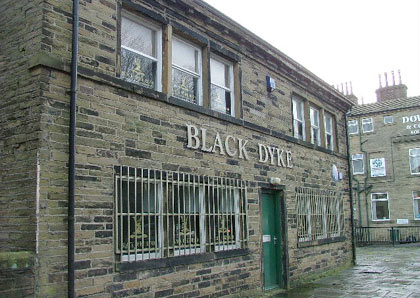
The spiritual home: Black Dyke's bandroom in Queensbury
The Lords cricket ground may have its famous Long Room packed to the rafters with relics and artifacts of the game, but directly opposite is the gleaming steel and glass media pod that looks like a cross between something from Star Trek and Cherie Blair's wide mouthed smile. The Royal Albert Hall meanwhile may look like a highly decorated Victorian sponge cake from the outside, but thanks to having over £70 million spent on it in the last few years, its innards can now accommodate state of art events without the performers having to get changed in cramped dressing rooms originally built to house one man and his performing dog.
The brass band world has found to its own cost that failure to invest in redevelopment has lost it its own spiritual home, when the decaying hulk that was Belle Vue was pulled down over 20 years ago.
Bands themselves face all these problems too, with perhaps the most famous band in the world currently in the process of ensuring that their spiritual home remains just that for years to come.
The famous Black Dyke bandroom sits innocuously on the main street in Queensbury. Car drivers who have to stop because of the junction traffic lights rarely give it a second glance, whilst in architectural terms it is a rather non descript building compared to the magnificent Victoria Hall a couple of hundred yards down the street and the exquisite Albert Memorial just around the corner. Over shadowing it is the imposing John Foster Mill, still in use, but no longer as a cloth manufacturing mill – a rather sad reminder of the failure to adapt and evolve.
The building (which is much bigger than it looks at first glance) was originally the mill's coach house and livery stable, built out of Yorkshire sandstone, with a stone tile roof. Constructed around 1840, there are few visible sign of its former use except for four cast iron rings set into the back of one of the walls which would have been used to tie up the horses. In later years it also housed the company shop whilst the bandroom entrance, which has long been replaced by a window, used to be at street level.
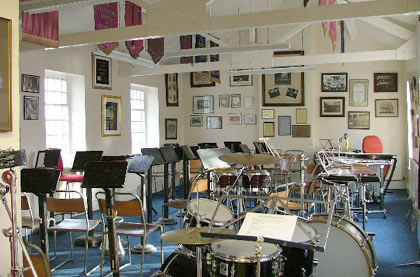
The most famous rehearsal room in the world:
The band took over use of the building around 1857 and with just a couple of short breaks for renovation has been there ever since. There is no other bandroom in the world quite like it, and as such it has rightly become something of an iconic place of brass band pilgrimage ever since.
Over the last few years however it had become apparent that it was no longer a reflection of the excellence of the band that performed in it, and even though some work had been undertaken to modernize, it was in need of something of an overhaul.
Unfortunately the benevolent patronage of the John Foster Company ended in the late 1990s and the company were forced to put the building up for sale - a decision that could have seen the most famous bandroom in the world turned into a Chinese restaurant. Fortunately, a group of local businessmen, including current band administrator Geoff Whiteley, all with a deep love for the band purchased it, reputedly for over £200,000 with the proviso that when the band itself could afford it, they would buy back from them for exactly the same price – a gesture of real benevolence John Foster himself would have been proud of, and one achieved by the band a few years later.
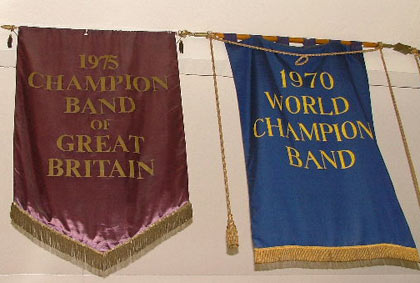
Banners of glory: Just two of the many mementoes of famous victories
In the meantime plans were drawn up to try and gain funding to help create a Centre of Excellence, but with the prohibitive costs involved in such major structural redevelopment that has been replaced by a realistic set of phased proposals that will enhance the structure of building without losing any of its historical character.
The current MD, Dr. Nicholas Childs has been a driving force behind the new redevelopment, although he is keen to point out that it has only been made possible by the active involvement of the players, administrators and supporters of the band.
"We have been acutely aware of the need to upgrade the inside of the building for some time. The bandroom attracts hundreds of visitors each year and we see it as a vital part of enhancing Black Dyke's profile all over the world. As a result we have just completed part two of a three phase enhancement with the third part hopefully to commence in the early part of this Summer. We have only been able to do it because everyone has leant a helping hand."
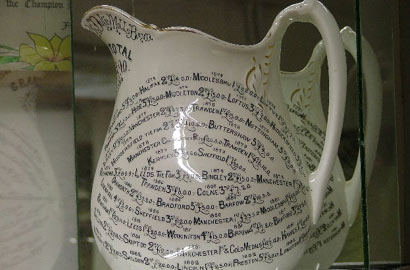
Details of success: One of the rare jugs commemorating Dyke victories from 1856 -1882
Phase 1 saw Nick and his band of helpers clear out the large lower floor room and turn it into a percussion storage facility, as well as enclosing the new heating system for the building. It now provides the band with the ability to store their concert and contest percussion equipment with access for loading and unloading, although Nick was keen to point out that this was only a temporary change of function for what will eventually become the new rehearsal room for the band.
"The room itself is exactly the same shape and size as the famous bandroom above, so we envisage that phase 3 of the redevelopment will see it become the new rehearsal facility for the band. We will be extending the floor area by adding an extra ten feet to the building so that we can accommodate all the percussion we need, as well as enabling us to provide state of the art acoustic seating for the players and make it much more comfortable area to rehearse in."
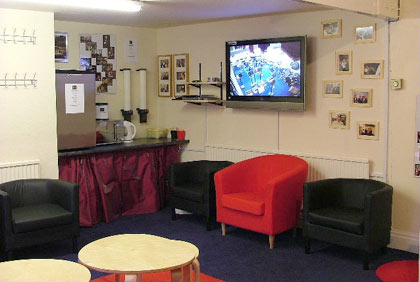
The new players lounge: All in Dyke colours of course
The will mean that the famous upstairs bandroom will be left untouched, although it will still be used for special occasions as well as allowing visitors to soak up the legendary atmosphere of a banding shrine that has played host to some of the greatest players and conductors in banding history without disturbing the current band whilst they practice.
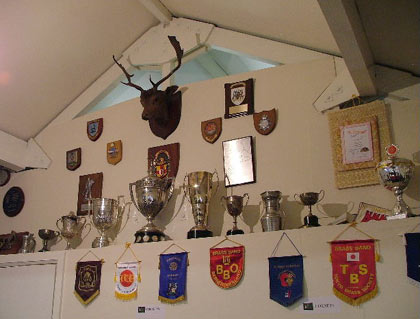
Prizes galore: Just some of the prizes won over the years now on show
In the meantime phase 2 has been completed with a major upgrading of the former upstairs storage area which has been turned into a plush players lounge (in band colours of course), the bandroom itself, and the main entrance hall which has been made much more welcoming and now displays memorabilia accumulated by the band over the past 150 years.
"With our players now coming from far and wide we felt it was necessary to give them the opportunity to relax before they start rehearsal. We have installed a work station with internet broadband to allow them to bring their work here as well as a refreshment area with fridge, hot and cold drinks and microwave."
Visitors will also be able to enjoy the band in rehearsal on a 50" plasma television, with the added bonus of being able to receive a memento of the practice from a recordable DVD player. "We felt it would be nice for visitors to not only enjoy the history of the bandroom with the memorabilia, trophies and mementoes, but also take home with them something for the future too in the form of a DVD of the band in practice."
The walls of the building are now resplendent with just a small proportion of that history, from the amazing collection of Crystal Palace medals, to the huge Freedom of The City of Bradford banner, pictures and autographs as diverse as The Beatles and Andre Previn, as well as the championship banners hanging from the bandroom rafters and the pictures of the great former conductors looking down on the current band as they prepare for future contest success. One lovely relic is the original band conductors stand which still bears the marks and worn away edges caused by the legendary Arthur O Pearce when he was bandmaster from 1912 – 1948, whilst a more poignant little memory can still be seen with the great Willie Lang's name carved on one of the original wooden stands still used by the current band.
On a more mundane level the toilets have been upgraded for both men and women, whilst the old bandroom carpet has finally been replaced after close on 40 years of use! "When we took it up I think it was only held together with dust and spit from the instruments," said Nick. "It wasn't the most pleasant thing we had to do, but it has been well worth it."
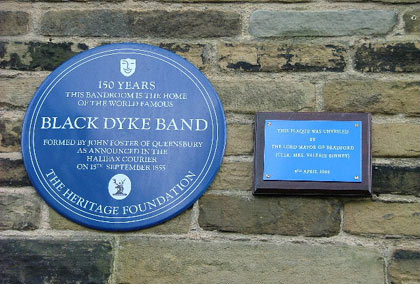
Not forgetting the heritage: The Blue Plaque celebrates 150 years of the band in Queensbury
Black Dyke's MD is very aware of the need to preserve the bands priceless heritage without losing out on providing it with a secure and welcoming base to launch future artistic success. He also hopes that the new developments will allow a greater proportion of memorabilia to be put on show for people to enjoy.
"I would love to be able to exhibit much more Black Dyke memorabilia and would ask anyone who has something that they think would enhance the bandroom to get in contact with us. I can assure them that it will be well looked after and displayed with acknowledgment to the person who has presented it. We have been very lucky that so many people associated with the band have contributed to making this possible, and I believe we will now have a 21st century bandroom that reflects Black Dykes future aims and ambitions without losing touch with its fantastic history."
Iwan Fox
This article also appears in British Bandsman magazine this week















